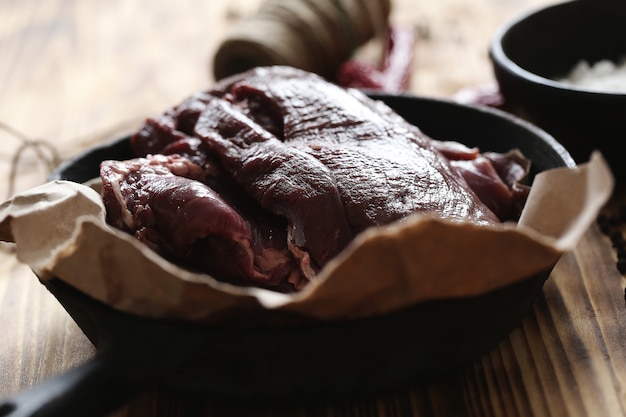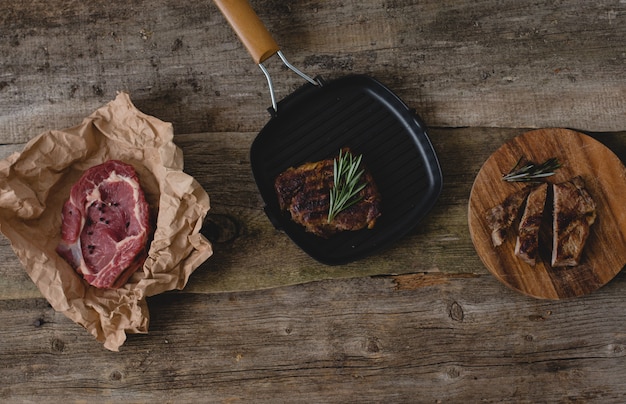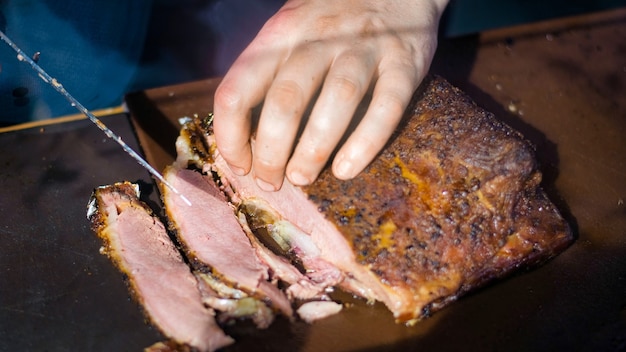(Part 1) The Right Cut: The Foundation of Flavor

Classic Cuts:
- Rib-eye: The king of steaks, the rib-eye boasts an impressive marbling of fat, which translates to incredible juiciness and flavour. It's a luxurious choice, worth every penny. Picture this: a thick, juicy slice with a beautiful, even sear, the fat melting into the meat, releasing an intoxicating aroma. That's the rib-eye, in all its glory.
- Sirloin: A dependable workhorse, the sirloin offers a balance of flavour and tenderness, without the hefty price tag of its more luxurious counterpart. It's a great choice for everyday grilling, providing a satisfyingly succulent experience that won't break the bank.
- new york strip: A leaner cut with a more intense flavour, the New York Strip is a favourite for its flat, even surface, making it ideal for grilling. It's like a more refined version of the sirloin, with a touch of assertive character.
Less Common, But Equally Delicious:
- filet mignon: The epitome of luxury, the Filet Mignon is known for its incredibly tender texture and delicate flavour. It's a treat for the senses, best enjoyed cooked rare to medium rare, as overcooking will diminish its delicate charm. This cut is all about subtlety, a whisper of flavour against a backdrop of luxurious tenderness.
- T-bone: A delicious combination of a tender filet mignon and a leaner strip steak, the T-bone offers a satisfying variety in each bite. It's a conversation starter, a piece of meat that says, "I'm not afraid of a little bit of everything."
(Part 2) Preparing for the Grill: A Steak's Transformation

The Salt Ritual:
I'm a firm believer in the "salt-early" method. Salting your steak at least 30 minutes before cooking allows the salt to penetrate the meat, drawing out moisture and then reabsorbing it, creating a more tender and flavorful steak. It's a simple trick, but it makes a world of difference. Imagine the salt crystals dancing on the surface of the steak, creating a glistening, almost magical effect.Spicing Up the Experience:
While salt is essential, don't limit yourself to the basics. Freshly ground black pepper is a classic pairing, but why stop there? A touch of garlic powder adds warmth, onion powder brings a hint of sweetness, and smoked paprika adds a touch of smoky depth. You can even experiment with herbs like rosemary or thyme for an added dimension of flavour. Each spice brings its own unique character to the table, allowing you to create your own signature steak blend.Bringing it to Room Temperature: The Key to Even Cooking
This step is often overlooked but crucial, especially if you're grilling or pan-searing. Taking your steak out of the fridge and letting it sit at room temperature for about 30 minutes ensures even cooking. A cold steak will shock the pan or grill, leading to uneven cooking and a less-than-ideal result. Imagine a steak evenly kissed by the heat, its interior warming slowly and evenly, a testament to the power of patience.(Part 3) The Art of Grilling: Embracing the Heat

The Hot Grill: A Steak's Best Friend
A hot grill is the key to a perfect sear. Aim for a temperature around 450-500°F (232-260°C). You'll know it's ready when you hold your hand above the grill for 3 seconds and it feels uncomfortably hot. This intense heat will create a beautiful, crisp crust, locking in the juices and creating a flavour explosion. Think of the grill as a culinary artist, painting the steak with a fiery brush, leaving its mark with a magnificent sear.Oiling for Success:
Before you toss your steak onto the hot metal, brush it with a light coating of oil. This prevents sticking and helps create that beautiful sear. The oil acts as a lubricant, allowing the steak to slide effortlessly across the grill, achieving an even, consistent sear on every surface.The Sizzle of Delight:
Place your steak on the grill and let it sizzle undisturbed for 3-4 minutes per side. Don't be tempted to move it around too much – you want that perfect sear! Imagine the sizzle as a conversation between the steak and the grill, a symphony of heat and fat, a testament to the magic of the grill.Turning the Tide: The Art of Indirect Heat
After you've seared both sides, move your steak to a cooler section of the grill or to the indirect heat zone, if your grill has one. This allows the steak to cook through evenly without burning. Think of this shift as a pause in the culinary drama, allowing the heat to penetrate the steak's core and cook it to perfection.(Part 4) The Cook Time Guide: Finding the Sweet Spot
Now we're getting to the heart of the matter – the cook time, the ultimate test of precision. Achieving that perfect medium rare takes careful timing and a keen eye.Steak Thickness and Cook Times: A Guide to Precision
Here's a general guideline, but remember, every steak is unique, and you'll develop your own intuition with experience.| Steak Thickness (inches) | Cook Time (minutes per side) |
|---|---|
| 1 | 4-5 |
| 1.5 | 5-6 |
| 2 | 6-7 |
Tips for Perfect Timing: A Masterful Approach
- meat thermometer: The Unsung Hero: Invest in a good meat thermometer – it's the most accurate way to ensure your steak reaches the desired internal temperature. A medium rare steak should register between 130-135°F (54-57°C). It's like a culinary compass, guiding you to the perfect haven of doneness.
- The Thumb Test: A Rough Guide: You can also use the "thumb test" as a less precise method, but it can be useful in a pinch. Press the palm of your hand just below your thumb. The firmness will roughly correspond to the doneness of your steak:
- Rare: Feels like your thumb, very soft.
- Medium Rare: Feels like your thumb, slightly firmer.
- Medium: Feels like the top of your hand, a bit firmer.
- Medium Well: Feels like the tip of your thumb, quite firm.
- Well Done: Feels like the tip of your thumb, very firm.
- Rest is Key: Allowing the Juices to Redistribute: After cooking, let your steak rest for 5-10 minutes before slicing and serving. This allows the juices to redistribute, resulting in a more tender and juicy steak. Think of this rest as a moment of reflection, allowing the steak to settle and release its full potential.
(Part 5) Pan-Searing: A Stellar Alternative for Grill-Less Adventures
Not everyone has a grill, but fear not! You can still achieve that glorious sear in a pan, bringing the magic of the grill into your kitchen.Heat It Up: The Foundation of a Perfect Sear
Heat a heavy-bottomed pan over medium-high heat. It should be piping hot – you want that satisfying sizzle! The pan, like a miniature volcano, will create the heat and energy needed for a beautifully caramelized crust.Oil for Smooth Sailing:
Add a tablespoon or two of oil to the pan and let it heat up. The oil will act as a conductor, transferring the heat evenly to the steak, creating a uniform sear that's a sight to behold.Sizzle and Sear: The Dance of Heat and Flavor
Place your steak in the pan and sear for 3-4 minutes per side. Use tongs to flip the steak for a nice crust. Imagine the sizzle as a song of heat and fat, a symphony of culinary delight.Finishing Touches: Bringing it Home
Once seared, you can either finish cooking the steak in the pan over low heat or transfer it to a preheated oven to cook through. The pan will become your personal stage, allowing you to control the heat and create a steak that's cooked to perfection.(Part 6) The Art of Patience: A Steak's Greatest Ally
One of the biggest mistakes people make when cooking steak is rushing the process. Resist the urge to constantly poke and prod your steak. Let it cook undisturbed, allowing the heat to do its work.Embrace the Silence:
Patience is a virtue, especially when it comes to cooking steak. Just like a good book, a good steak needs time to unfold its flavor. Let the heat do its magic, transforming the meat into a culinary masterpiece.Time is on Your Side: Allowing the Heat to Work its Magic
Give your steak the time it needs to reach the desired doneness. Resist the urge to rush the process. Let the heat slowly penetrate the meat, releasing its natural juices and creating a steak that's tender, juicy, and full of flavour.(Part 7) Mastering the Rest: The Secret to Juicy Perfection
After the glorious sizzle and the beautiful sear, it's time to let your steak rest. This is an often overlooked step, but it's crucial for achieving a juicy and tender steak.Resting Time: A Crucial Pause in the culinary journey
Once your steak is cooked, transfer it to a cutting board and let it rest for at least 5-10 minutes.The Science of Rest: A Tale of Redistributed Juices
During cooking, the steak's juices get pushed to the surface. By letting it rest, those juices have time to redistribute back into the meat, resulting in a more tender and juicy steak. Imagine the juices flowing back into the meat, rehydrating it, creating a symphony of flavour that explodes with every bite.(Part 8) Serving It Up: A Culinary Celebration
The moment of truth has arrived! Your perfectly cooked steak is ready to be savored.Slicing It Right: The Art of Release
Slice your steak against the grain, creating thin, tender slices. This helps release the juices and makes the steak easier to chew. Picture the knife gliding through the meat, releasing the juicy nectar that lies within.The Perfect Accompaniments: Completing the Symphony
No steak is complete without the right accompaniments. Roasted vegetables, creamy mashed potatoes, or a vibrant salad all complement the rich flavour of the steak. Think of them as the supporting cast, bringing their own unique flavour and texture to the stage, enhancing the steak's brilliance.The Final Touches: Elevating the Steak to New Heights
A drizzle of melted butter, a sprinkle of herbs, or a squeeze of lemon juice can elevate your steak to new heights. These finishing touches are like the final flourish on a masterpiece, adding a touch of elegance and sophistication.(Part 9) FAQs: Unlocking the Secrets of Steak
You've got questions, I've got answers!Q1: What if my steak is a bit thicker or thinner than the guide suggests?
A: Use the guide as a starting point and adjust your cooking times based on the thickness of your steak. You can always check the internal temperature with a meat thermometer to ensure it's cooked to your liking. Think of the guide as a roadmap, allowing you to navigate the journey of cooking the perfect steak, even with variations in thickness.Q2: How do I know if my steak is done without using a thermometer?
A: The "thumb test" can be a helpful guide, but remember, it's not always accurate.- Rare: Feels like your thumb, very soft.
- Medium Rare: Feels like your thumb, slightly firmer.
- Medium: Feels like the top of your hand, a bit firmer.
- Medium Well: Feels like the tip of your thumb, quite firm.
- Well Done: Feels like the tip of your thumb, very firm.
Q3: What happens if I overcook my steak?
A: An overcooked steak will be dry and tough. The juices will escape, leaving the meat dry and flavourless. It's like a beautiful melody turning into a harsh, discordant noise.Q4: Can I cook steak in the oven?
A: Absolutely! You can achieve a beautiful sear on the stovetop and then finish cooking the steak in a preheated oven. This ensures even cooking throughout. Think of the oven as a supportive teammate, helping you achieve a perfectly cooked steak, even without a grill.Q5: What are some tips for making steak more flavourful?
A:- Marinate: Marinating your steak in a flavorful mixture like soy sauce, garlic, and ginger can add a depth of flavor. Think of the marinade as a secret sauce, infusing the steak with a symphony of tastes.
- Use a flavorful butter: Top your cooked steak with a pat of herb-infused butter or garlic butter for an extra burst of flavor. The butter, like a final touch of magic, adds a richness and complexity that elevates the steak to new heights.
- Experiment with spices: Don't be afraid to experiment with different spices like smoked paprika, chili powder, or even a touch of cayenne pepper. Each spice brings its own unique character, allowing you to create your own signature steak blend.
(Part 10) The Final Word: Enjoy Your Culinary Triumph
So there you have it, my friends! The ultimate guide to cooking the perfect medium rare steak. Remember, practice makes perfect, so don't be afraid to experiment and find what works best for you. And most importantly, enjoy the journey! The satisfaction of a perfectly cooked steak is truly a culinary triumph. Now go out there and impress your friends and family with your newfound steak skills!Everyone is watching

How to Cook Frozen Lobster Tails Perfectly: A Step-by-Step Guide
RecipesLobster. Just the word conjures up images of lavish meals, special occasions, and a taste of luxury. But let's...

Pigs in a Blanket Cooking Time: How Long to Bake for Perfect Results
RecipesAh, pigs in a blanket. Just the name conjures up images of those delightful little parcels of crispy pastry en...

Pork Fillet Cooking Time: How Long to Cook It Perfectly
RecipesPork fillet, or tenderloin as it's sometimes called, is a real favourite in our house. It's so versatile, and...

The Ultimate Guide to Tender, Juicy Pulled Pork
RecipesRight, let's talk pulled pork. It's one of those dishes that just screams "comfort food," doesn't it? I mean...

The Ultimate Guide to Cooking Delicious Frankfurters
RecipesLet's face it, we all love a good frankfurter. It's a classic, simple, and always satisfying. But let's be rea...
